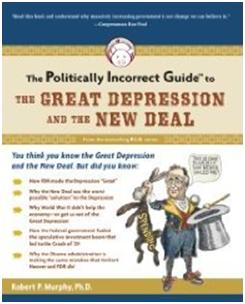If deficit spending were truly stimulative, then why didn’t the Bush deficits stimulate the economy?
If World War II brought us out of the Great Depression, then shouldn’t the War in Iraq have stimulated the US economy?
 These are just two of the provocative questions raised in the new Politically Incorrect Guide to the Great Depression and the New Deal, by Robert P. Murphy, scheduled for release next month, but already shipping and available now from Greenleaf.
These are just two of the provocative questions raised in the new Politically Incorrect Guide to the Great Depression and the New Deal, by Robert P. Murphy, scheduled for release next month, but already shipping and available now from Greenleaf.
Murphy is eminently well-qualified for the topic. A Ph.D. economist, he was a professor at Hillsdale College and is now an adjunct scholar with the Ludwig von Mises Institute.
Here’s the most striking sentence in the book (in my humble opinion):
“Economies recover from recessions or depressions by reallocating labor and capital to their most efficient uses. Propping up ailing industries only delays that necessary process and thereby deepens the weaknesses of an economy and delays recovery.” page 66
The book is divided into eight sections:
Ch. 1 The Crisis
The Roaring Twenties; The Onset of the Great Depression; FDR and the New Deal; The 1937-38 “Depression Within the Depression;” Rosie the Riveter: Happy Times are Here Again; Just the Facts Ma’am? The Need for Interpretation; The Reason Why; If a Policy Failed in the 1930s, Why Would it Work Today?
Ch. 2 Big-Government Herbert Hoover Makes the Depression Great
Herbert Hoover: Consistent Critic of Capitalism; Hoover’s “New Economics;” Making the Depression Great, Step 1: Prop up Wages; Making the Depression Great, Step 2: Cripple International Trade; Making the Depression Great, Step 3: Tax-and-Spend Like a Democrat; Making the Depression Great, Step 4: Install a New Deal-Lite; Herbert Hoover: A Big Government Man
Ch. 3 Did the Tightwad Fed’s Deflation Cause the Great Depression?
Friedman: The Timid Fed and the Deflation in the 1930s; Who’s Afraid of Falling Prices?; Deflation: Historical Evidence; But Why Would the Fed Destroy Money?; Propping up Losers;
Ch. 4 Did Conservative Economic Policies Cause the Depression?
The Roaring ’20s; Andrew Mellon’s Incredible Tax Cuts; Was the Depression payback for the 1920s Boom?; How Did the Classical Gold Standard Work?; Did the Gold Standard Cause the Depression?; The Final Verdict on Gold
Ch. 5 The Failures of the New Deal
Continuing the Work of Hoover: Restricting Production and Raising Wages; The Only Thing We Have to Fear Is Roosevelt Himself
Ch. 6 The Outrages of the New Deal
Roosevelt’s “Bank Holiday;” Going Off Gold; The National Recovery Administration: Big Government and Big Business Join Forces; How the New Deal Helped Poor People Go Hungry; Old Age insurance: Not Really Insurance, and Neither Social nor Secure
Ch. 7 The Myth of Wartime Prosperity
The Immortal Error: The Broken Window Fallacy; A Billion Wrongs Don’t Make a Right; Wartime Prosperity? Damned Lies and Statistics; Central Planning: Bad in Peacetime, Deadly in War; Postscript: Ways in which World War II Did Boost American Production
Ch. 8 The Great Depression: Lessons for Today
The Fed Caused the Housing Boom – and Bust; The Myth of Laissez-Faire George Bush; Is Barack Obama the New FDR?
Here are some other thought-provoking observations:
The creation of the FDIC may have created a moral hazard of banks. The existence of the FDIC actually induces banks to make risky loans, by insulating them from the risks, and thus preventing them from learning the consequences of making bad loans.
The “bank holidays” begun by various state governors and eventually instituted nationally by FDR actually introduced additional uncertainty into the banking system and may have contributed to the climate which caused “runs” on various banks.
The National Recovery Administration price codes resulted in such absurd tyrannies as the jailing and fining of a New Jersey tailor who insisted on charging 35 cents to press a suit of clothes when the NRA price code set the amount at 40 cents.
This is a VERY timely book. Highly recommended for high school students and up who want to understand the economic history of the US and how it is being mis-used in the current crisis.
The Politically Incorrect Guide to the Great Depression and the New Deal
is a paperback, 198 pages and is available from Greenleaf Press for $19.95.